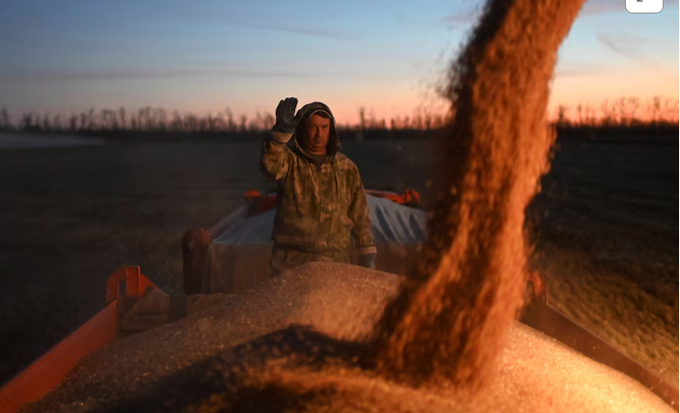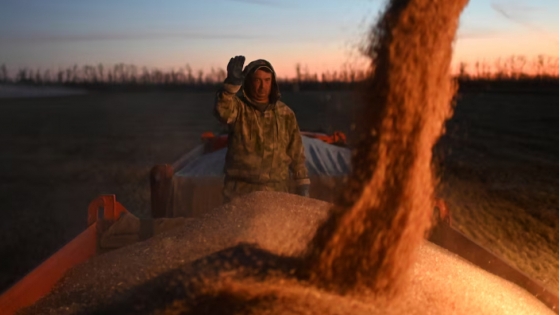(VAN) Russian farmers say they will sow less wheat after heavy losses this year, switching to more profitable crops such as peas, lentils, or sunflowers.

A farmer watches a combine loading wheat into a truck during harvesting in a field of a local agricultural enterprise in the Cherlaksky district of the Omsk region, Russia, October 4, 2024.
Such decisions will have direct implications for global wheat prices and inflation in major buyers like Egypt, as Russia is the world’s top exporter of the grain.
The trend represents a challenge for President Vladimir Putin’s plan to expand exports and cement Russia’s position as an agriculture superpower, giving it more international clout amid confrontation with the West over its actions in Ukraine.
The country’s wheat harvest will decline to 83 million tons this year due to frosts and drought, down from 92.8 million tons in 2023 and a record 104.2 million tons in 2022. New forecasts point to a clouded outlook for next year as well.
Although Russia has been exporting wheat at a near record pace in the recent months, exports are expected to slow due to a bad harvest and export curbs aimed at containing domestic price growth, including an expected cut in export quota by two-thirds from January 2025.
At a farm in Siberia’s Omsk region, which was hit by heavy rain during the peak of the harvesting season, farmer Maxim Levshunov takes advantage of a rare sunny day to collect what remains in the fields.
He chuckles as he picks up ears of wheat that sprouted early due to the moisture. Now, most of his crops are only suitable for animal feed, meaning the farm will receive a fraction of the price it had hoped for.
“We’ll probably start moving away from wheat, cutting back as much as possible. So, we’ll be thinking about what more profitable crops we can replace it with right now,” Levshunov told Reuters.
As this year’s harvesting campaign comes to an end, Russian farmers are assessing their losses from the exceptionally bad weather and considering their next steps amid falling profit margins for wheat, Russia’s main agricultural export.
Winter wheat became the first victim as areas sown with it are set to shrink by 10% this year, the lowest since 2019, according to data from Rusagrotrans, Russia’s flagship grain rail carrier.
“There are losses on each ton. The selling price does not cover the cost,” said Arkady Zlochevsky, head of the Russian Grain Union industry lobby, predicting that Russia’s 26% share of the global wheat trade will shrink.
MORE PROFITABLE CROPS
Agriculture Minister Oksana Lut joked that farmers might pray to Saint Ilya, the patron saint of weather in Russia, to improve conditions for winter crops. The joke did not go down well with farmers, who are considering more pragmatic options.
Some say they have already decided to plant less wheat next year. Others are waiting to see how global wheat prices perform in the next few weeks before making a final decision.
“The profitability of grain crops is approaching zero. The company has reduced the volume of winter wheat sowing by 30%. There are two drivers now — soybeans and sunflower,” said Dmitry Garnov, CEO of Rostagro Group, which owns land in the Penza and Saratov regions around the Volga River.
Rising costs of equipment and fuel, high export duties, a rising benchmark interest rate that hit 21% in October as the country’s central bank fights inflation, and the removal of some agricultural subsidies have also eaten into profit margins.
“It is evident that in 2022-2024, the price has been practically the same, while the cost of grain production has increased by at least 28%,” said Sergei Lisovsky, a member of the lower house of Russia’s parliament from the Kurgan region.
Lisovsky argued that the high export duty for grains, introduced in 2021, as well as rising transportation costs for regions with no direct access to seaports, were also factors behind low margins.
“Therefore, as of today, farmers are not planting grain not because of the autumn drought, but because they are waiting to see what the price will be, and have not yet made a decision,” Lisovsky added, referring to spring wheat sowing.
NICHE CROPS
In Russia’s most fertile Krasnodar region, the profitability of wheat is still holding around 10%, but some large local farms are also pondering a change of strategy as droughts become more severe each year.
“It is gradually getting warmer in the south, and we need to think about changing the structure of the sowing areas for the future,” said Yevgeny Gromyko, executive from Tkachev Agrocomplex, one of Russia’s largest landowners, and a former deputy agriculture minister.
The niche crops have the potential to become new export success stories with Russia’s allies among the BRICS countries, aiding the government in achieving Putin’s goal of increasing agricultural exports by half by 2030.
Russia overtook Canada this year as the top peas exporter to China while regulators in India, the leading importer of lentils, used to make daal, a staple for millions of people, gave a green light to Russian imports.
Russia takes great pride in being the world’s top wheat exporter, with the older generation recalling the food shortages of the Soviet era and the humiliating grain imports from Cold War foes like the United States and Canada.
However, for struggling farmers, it is declining profits, not global status, that matter most.
“Many farms that specialised exclusively in wheat crops have operated at a loss this year and will face very serious financial difficulties, potentially leading to bankruptcy,” Levshunov said.
Agriculture News | Agri Products Price



